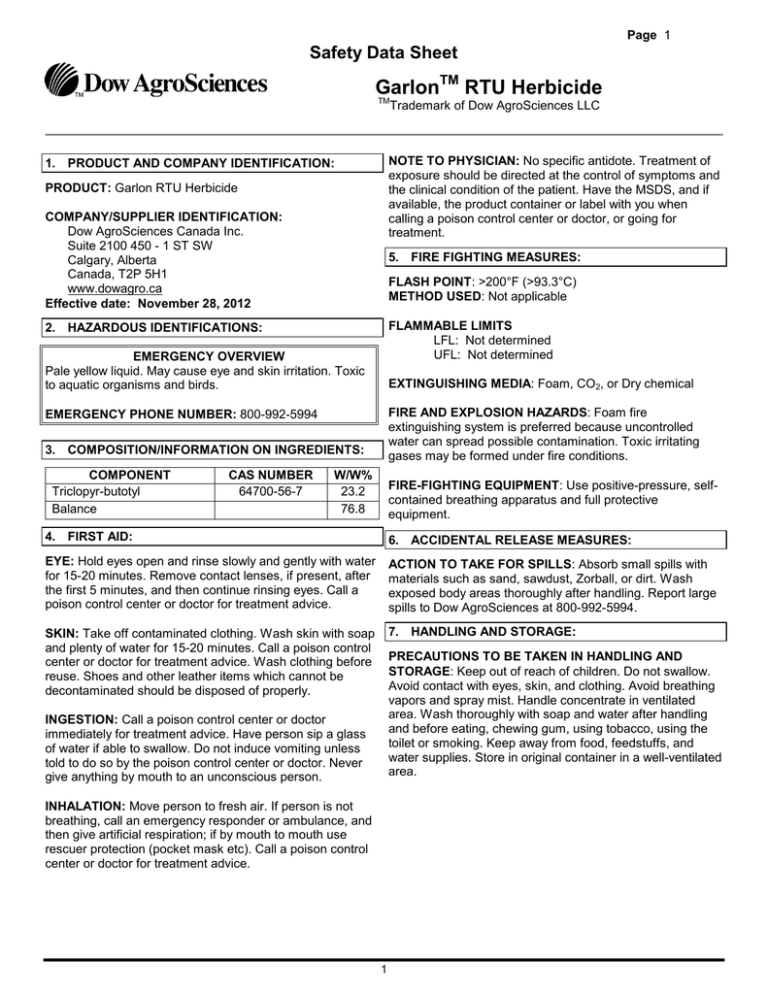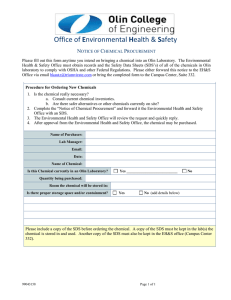Garlon RTU Herbicide - The DOW Chemical Company
advertisement

Page 1 Safety Data Sheet TM Garlon RTU Herbicide TM Trademark of Dow AgroSciences LLC NOTE TO PHYSICIAN: No specific antidote. Treatment of exposure should be directed at the control of symptoms and the clinical condition of the patient. Have the MSDS, and if available, the product container or label with you when calling a poison control center or doctor, or going for treatment. 1. PRODUCT AND COMPANY IDENTIFICATION: PRODUCT: Garlon RTU Herbicide COMPANY/SUPPLIER IDENTIFICATION: Dow AgroSciences Canada Inc. Suite 2100 450 - 1 ST SW Calgary, Alberta Canada, T2P 5H1 www.dowagro.ca Effective date: November 28, 2012 5. FIRE FIGHTING MEASURES: FLASH POINT: >200°F (>93.3°C) METHOD USED: Not applicable FLAMMABLE LIMITS LFL: Not determined UFL: Not determined 2. HAZARDOUS IDENTIFICATIONS: EMERGENCY OVERVIEW Pale yellow liquid. May cause eye and skin irritation. Toxic to aquatic organisms and birds. EXTINGUISHING MEDIA: Foam, CO2, or Dry chemical FIRE AND EXPLOSION HAZARDS: Foam fire extinguishing system is preferred because uncontrolled water can spread possible contamination. Toxic irritating gases may be formed under fire conditions. EMERGENCY PHONE NUMBER: 800-992-5994 3. COMPOSITION/INFORMATION ON INGREDIENTS: COMPONENT Triclopyr-butotyl Balance CAS NUMBER 64700-56-7 W/W% 23.2 76.8 FIRE-FIGHTING EQUIPMENT: Use positive-pressure, selfcontained breathing apparatus and full protective equipment. 4. FIRST AID: 6. ACCIDENTAL RELEASE MEASURES: EYE: Hold eyes open and rinse slowly and gently with water for 15-20 minutes. Remove contact lenses, if present, after the first 5 minutes, and then continue rinsing eyes. Call a poison control center or doctor for treatment advice. ACTION TO TAKE FOR SPILLS: Absorb small spills with materials such as sand, sawdust, Zorball, or dirt. Wash exposed body areas thoroughly after handling. Report large spills to Dow AgroSciences at 800-992-5994. SKIN: Take off contaminated clothing. Wash skin with soap and plenty of water for 15-20 minutes. Call a poison control center or doctor for treatment advice. Wash clothing before reuse. Shoes and other leather items which cannot be decontaminated should be disposed of properly. 7. HANDLING AND STORAGE: PRECAUTIONS TO BE TAKEN IN HANDLING AND STORAGE: Keep out of reach of children. Do not swallow. Avoid contact with eyes, skin, and clothing. Avoid breathing vapors and spray mist. Handle concentrate in ventilated area. Wash thoroughly with soap and water after handling and before eating, chewing gum, using tobacco, using the toilet or smoking. Keep away from food, feedstuffs, and water supplies. Store in original container in a well-ventilated area. INGESTION: Call a poison control center or doctor immediately for treatment advice. Have person sip a glass of water if able to swallow. Do not induce vomiting unless told to do so by the poison control center or doctor. Never give anything by mouth to an unconscious person. INHALATION: Move person to fresh air. If person is not breathing, call an emergency responder or ambulance, and then give artificial respiration; if by mouth to mouth use rescuer protection (pocket mask etc). Call a poison control center or doctor for treatment advice. 1 Page 2 Safety Data Sheet TM Garlon RTU Herbicide TM Trademark of Dow AgroSciences LLC materials, as well as the instructions/specifications provided by the glove supplier. 8. EXPOSURE CONTROLS/PERSONAL PROTECTION: These precautions are suggested for conditions where the potential for exposure exists. Emergency conditions may require additional precautions. RESPIRATORY PROTECTION: Atmospheric levels should be maintained below the exposure guideline. When respiratory protection is required for certain operations, use an approved air-purifying or positive-pressure supplied-air respirator depending on the potential airborne concentration. For emergency and other conditions where the exposure guideline may be exceeded, use an approved positivepressure self-contained breathing apparatus or positivepressure air line with auxiliary self-contained air supply. The following should be effective types of air-purifying respirators: organic vapor cartridge with a particulate prefilter. EXPOSURE GUIDELINES: Triclopyr Acid: Dow AgroSciences Industrial Hygiene Guide is 2 mg/M3 as acid equivalent, Skin. A “skin” notation following the exposure guideline refers to the potential for dermal absorption of the material including mucous membranes and the eyes either by contact with vapors or by direct skin contact. It is intended to alert the reader that inhalation may not be the only route of exposure and that measures to minimize dermal exposures should be considered. APPLICATORS AND ALL OTHER HANDLERS: Refer to the product label for personal protective clothing and ENGINEERING CONTROLS: Provide general and/or local equipment. exhaust ventilation to control airborne levels below the 9. PHYSICAL AND CHEMICAL PROPERTIES: exposure guidelines. APPEARANCE: Pale yellow liquid ODOR: None DENSITY: 0.865 g/mL RECOMMENDATIONS FOR MANUFACTURING, COMMERCIAL BLENDING, AND PACKAGING WORKERS: 10. STABILITY AND REACTIVITY: EYE/FACE PROTECTION: Use chemical goggles. STABILITY: (CONDITIONS TO AVOID) Combustible. Stable under normal storage conditions. SKIN PROTECTION: Use chemical protective clothing resistant to this material, when there is any possibility of skin contact. Use protective clothing chemically resistant to this material. Selection of specific items such as face shield, boots, apron, or full body suit will depend on the task. Wear a face-shield which allows use of chemical goggles, or wear a full-face respirator, to protect face and eyes when there is any likelihood of splashes. Safety shower should be located in immediate work area. Remove contaminated clothing immediately, wash skin area with soap and water, and launder clothing before reuse or dispose of properly. Items which cannot be decontaminated, such as shoes, belts and watchbands, should be removed and disposed of properly. HAND PROTECTION: Use gloves chemically resistant to this material when prolonged or frequently repeated contact could occur. Examples of preferred glove barrier materials include: Butyl rubber, Polyethylene, Neoprene, Chlorinated polyethylene, Ethyl vinyl alcohol laminate (“EVAL). Examples of acceptable glove barrier materials include: Viton, Natural rubber (“Latex”), Polyvinyl chloride (“PVC” or “vinyl”), Nitrile/butadiene rubber (“Nitrile” or “NBR”). NOTICE: the selection of a specific glove for a particular application and duration of use in a workplace should also take into account all relevant workplace factors such as, but not limited to: other chemicals which may be handled, physical requirements (cut/puncture protection, dexterity, thermal protection), potential body reactions to glove INCOMPATIBILITY: (SPECIFIC MATERIALS TO AVOID) Acids, bases and oxidizing materials. HAZARDOUS DECOMPOSITION PRODUCTS: Nitrogen oxides, hydrogen chloride, and phosgene may result under fire conditions. HAZARDOUS POLYMERIZATION: Not known to occur. 11. TOXICOLOGICAL INFORMATION: EYE: May cause eye irritation. Corneal injury is unlikely. SKIN: Brief contact may cause slight skin irritation with local redness. Prolonged skin contact is unlikely to result in absorption of harmful amounts. Has caused allergic skin reactions when tested in mice. The dermal LD50 for male and female rats is >5,000 mg/kg. INGESTION: Low toxicity if swallowed. Small amounts swallowed incidentally as a result of normal handling operations are not likely to cause injury; however, swallowing larger amounts may cause injury. The oral LD50 for rats, female, is 3,200 mg/kg. 2 Page 3 Safety Data Sheet TM Garlon RTU Herbicide TM Trademark of Dow AgroSciences LLC This information presented below only applies to the material as supplied. The identification based on characteristic(s) or listing may not apply if the material has been used or otherwise contaminated. It is the responsibility SYSTEMIC (OTHER TARGET ORGAN) EFFECTS: For the of the waste generator to determine the toxicity and physical active ingredient, in animals, effects have been reported on properties of the material generated to determine the proper waste identification and disposal methods in compliance the following organs: blood, kidney and liver. with applicable regulations. CANCER INFORMATION: Similar active ingredient(s) did If the material as supplied becomes a waste, follow all not cause cancer in laboratory animals. applicable regional, national and local laws and regulations. TERATOLOGY (BIRTH DEFECTS): The active ingredient 14. TRANSPORT INFORMATION: did not cause birth defects in laboratory animals. Has been toxic to the fetus in laboratory animals only at doses toxic to TRANSPORTATION OF DANGEROUS GOODS the mother. INFORMATION: INHALATION: No adverse effects are anticipated from single exposure to mist. The aerosol LC50 for male and female rats, 4 hr., is >5.37 mg/l. REPRODUCTIVE EFFECTS: For a similar active ingredient, For all shipments: This material is not regulated for transport. in laboratory animal studies, effects on reproduction have been seen only at doses that produced significant toxicity to 15. REGULATORY INFORMATION: the parent animals. Pest Control Products Act registration number:29334 For information phone: 800 667 3852 MUTAGENICITY: For the active ingredient, in-vitro and animal genetic toxicity studies were negative. 16. Other Information: National Fire Code classification: Not applicable 12. ECOLOGICAL INFORMATION: ENVIRONMENTAL FATE: Notice: The information contained in this Safety Data Sheet (“SDS”) is current as of the effective date shown in Section 1 of this SDS and may be subject to amendment by Dow AgroSciences Canada Inc. (“DASCI”) at any time. DASCI accepts no liability whatsoever which results in any way from the use of SDS that are not published by DASCI, or have been amended without DASCI express written authorization. Users of this SDS must satisfy themselves that they have the most recent and authorized version of this SDS and shall bear all responsibility and liability with respect thereto. Any conflict or inconsistencies as to the contents of this SDS shall be resolved in favor of DASCI by the most recent version of the SDS published by DASCI. MOVEMENT & PARTITIONING: Bioconcentration potential is moderate (BCF is between 100 and 3000 or Log Pow between 3 and 5). DEGRADATION & PERSISTENCE: Based largely or completely on information for triclopyrbutotyl. Material is expected to biodegrade only very slowly (in the environment). Fails to pass OECD/EEC tests for ready biodegradability. ECOTOXICOLOGY: Based largely or completely on information for triclopyrbutotyl. Material is highly toxic to aquatic organisms on an acute This SDS based on GF2059 US RSSDS SDS basis (LC50 or EC50 is between 0.1 and 1 mg/L in the most sensitive species tested). Material is slightly toxic to birds on an acute basis (LD50 is between 501 and 2000 mg/kg). Material is practically non-toxic to birds on a dietary basis (LC50 is >5000 ppm). 13. DISPOSAL CONSIDERATIONS: DISPOSAL METHOD: If wastes and/or containers cannot be disposed of according to the product label directions, disposal of this material must be in accordance with your local or area regulatory authorities. 3



